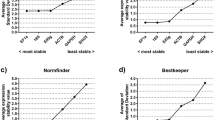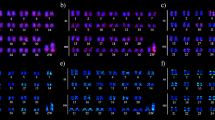Abstract
The Glanville fritillary butterfly (Melitaea cinxia; Nymphalidae) has been extensively studied as a model species in metapopulation ecology. We investigated in the earlier studies that female butterflies exhibit higher thermal tolerance than males in the Tianshan Mountains of China. We aim to understand the molecular mechanism of differences of thermal responses between sexes. We used RNA-seq approach and performed de novo assembly of transcriptome to compare the gene expression patterns between two sexes after heat stress. All the reads were assembled into 84,376 transcripts and 72,701 unigenes. The number of differential expressed genes (DEGs) between control and heat shock samples was 175 and 268 for males and females, respectively. Heat shock proteins genes (hsps) were up-regulated in response to heat stress in both males and females. Most of the up-regulated hsps showed higher fold changes in males than in females. Females expressed more ribosomal subunit protein genes, transcriptional elongation factor genes, and methionine-rich storage protein genes, participating in protein synthesis. It indicated that protein synthesis is needed for females to replace the damaged proteins due to heat shock. In addition, aspartate decarboxylase might contribute to thermal tolerance in females. These differences in gene expression may at least partly explain the response to high temperature stress, and the fact that females exhibit higher thermal tolerance.




Similar content being viewed by others
References
Clarke A (2003) Costs and consequences of evolutionary temperature adaptation. Trends Ecol Evol 18:573–581
Angilletta MJ, Niewiarowski PH, Navas CA (2002) The evolution of thermal physiology in ectotherms. J Therm Biol 27:249–268
Hoffmann AA, Anderson A, Hallas R (2002) Opposing clines for high and low temperature resistance in Drosophila melanogaster. Ecol Lett 5:614–618
Zeilstra I, Fischer K (2005) Cold tolerance in relation to developmental and adult temperature in a butterfly. Physiol Entomol 30:92–95
Fallis LC, Fanara JJ, Morgan TJ (2014) Developmental thermal plasticity among Drosophila melanogaster populations. J Evolution Biol 27:557–564
Latimer CAL, Wilson RS, Chenoweth SF (2011) Quantitative genetic variation for thermal performance curves within and among natural populations of Drosophila serrata. J Evolution Biol 24:965–975
Franks SJ, Hoffmann AA (2012) Genetics of climate change adaptation. Annu Rev Genet 46:185–208
Freitak D, Knorr E, Vogel H, Vilcinskas A (2012) Gender- and stressor-specific microRNA expression in Tribolium castaneum. Biol Lett 8:860–863
Pezer Z, Ugarkovic D (2012) Satellite DNA-associated siRNAs as mediators of heat shock response in insects. RNA Biol 9:587–595
Neven LG (2000) Physiological responses of insects to heat. Postharvest Biol Technol 21:103–111
Parsell DA, Lindquist S (1993) The function of heat-shock proteins in stress tolerance: degradation and reactivation of damaged proteins. Annu Rev Genet 27:437–496
Koštál V, Tollarová-Borovanská M (2009) The 70 kda heat shock protein assists during the repair of chilling injury in the insect, Pyrrhocoris apterus. PLoS One 4:e4546
Bahrndorff S, Marien J, Loeschcke V, Ellers J (2010) Genetic variation in heat resistance and HSP70 expression in inbred isofemale lines of the springtail Orchesella cincta. Climate Res 43:41–47
Štĕtina T, Koštál V, Korbelová J (2015) The role of inducible Hsp70, and other heat shock proteins, in adaptive complex of cold tolerance of the fruit fly (Drosophila melanogaster). PLoS One 10:e0128976
Riddoch BJ (1993) The adaptive significance of electrophoretic mobility in phosphoglucose isomerase (PGI). Biol J Linn Soc 50:1–17
Neargarder G, Dahlhoff EP, Rank NE (2003) Variation in thermal tolerance is linked to phosphoglucose isomerase genotype in a montane leaf beetle. Funct Ecol 17:213–221
Hughes JM, Zalucki MP (1993) The relationship between the Pgi locus and the ability to fly at low-temperatures in the monarch butterfly Danaus plexippus. Biochem Genet 31:521–532
Sørensen JG, Loeschcke V, Kristensen TN (2009) Lessons from the use of genetically modified Drosophila melanogaster in ecological studies: Hsf mutant lines show highly trait-specific performance in field and laboratory thermal assays. Funct Ecol 23:240–247
Udaka H, Percival-Smith A, Sinclair BJ (2013) Increased abundance of Frost mRNA during recovery from cold stress is not essential for cold tolerance in adult Drosophila melanogaster. Insect Mol Biol 22:541–550
Anderson AR, Collinge JE, Hoffmann AA, Kellett M, McKechnie SW (2003) Thermal tolerance trade-offs associated with the right arm of chromosome 3 and marked by the hsr-omega gene in Drosophila melanogaster. Heredity 9:195–202
Crawford JE, Guelbeogo WM, Sanou A, Traore A, Vernick KD, Sagnon N, Lazzaro BP (2010) De Novo transcriptome sequencing in Anopheles funestus using Illumina RNA-Seq technology. PLoS One 5:e1420212
Xu P, Liu ZW, Fan XQ, Gao J, Zhang X, Zhang XG, Shen XL (2013) De novo transcriptome sequencing and comparative analysis of differentially expressed genes in Gossypium aridum under salt stress. Gene 525:26–34
Vogel H, Badapanda C, Knorr E, Vilcinskas A (2014) RNA-sequencing analysis reveals abundant developmental stage-specific and immunity-related genes in the pollen beetle Meligethes aeneus. Insect Mol Biol 23:98–112
Ehrlich PR, Hanski I (2004) On the wings of checkerspots: a model system for population biology. Oxford University Press, New York
Wahlberg N, Saccheri I (2007) The effects of pleistocene glaciations on the phylogeography of Melitaea cinxia (Lepidoptera: Nymphalidae). Eur J Entomol 104:675–684
Zhou Y, Cao YD, Chen HQ, Long Y, Yan FM, Xu CR, Wang RJ (2012) Habitat utilization of the Glanville fritillary butterfly in the Tianshan Mountains, China, and its implication for conservation. J Insect Conserv 16:207–214
Zhou Y, Xu C, Chen HQ, Zhang DD, Long Y, Yan FM, Xu CR, Wang RJ (2013) Different male mate location behaviour of the Glanville fritillary butterfly in different landscapes in the Tianshan Mountains, northwestern China. Entomol Fennica 24:129–139
Luo SQ, Wong SC, Xu C, Hanski I, Wang RJ, Lehtonen R (2014) Phenotypic plasticity in thermal tolerance in the Glanville fritillary butterfly. J Therm Biol 42:33–39
Luo SQ, Ahola V, Shu C, Xu CR, Wang RJ (2015) Heat shock protein 70 gene family in the Glanville fritillary butterfly and their response to thermal stress. Gene 556:132–141
Haas BJ, Papanicolaou A, Yassour M, Grabherr M, Blood PD, Bowden J, Couger MB, Eccles D, Li B, Lieber M (2013) De novo transcript sequence reconstruction from RNA-seq using the Trinity platform for reference generation and analysis. Nat Protoc 8:1494–1512
Ahola V, Lehtonen R, Somervuo P, Salmela L, Koskinen P, Rastas P, Välimäki N, Paulin L, Kvist J, Wahlberg N, Tanskanen J, Hornett EA, Ferguson LC, Luo S, Cao Z, de Jong MA, Duplouy A, Smolander OP, Vogel H, McCoy RC, Qian K, Chong WS, Zhang Q, Ahmad F, Haukka JK, Joshi A, Salojärvi J, Wheat CW, Grosse-Wilde E, Hughes D, Katainen R, Pitkänen E, Ylinen J, Waterhouse RM, Turunen M, Vähärautio A, Ojanen SP, Schulman AH, Taipale M, Lawson D, Ukkonen E, Mäkinen V, Goldsmith MR, Holm L, Auvinen P, Frilander MJ, Hanski I (2014) The Glanville fritillary genome retains an ancient karyotype and reveals selective chromosomal fusions in Lepidoptera. Nat Commun 5:4737–4737
Li W, Godzik A (2006) Cd-hit: a fast program for clustering and comparing large sets of protein or nucleotide sequences. Bioinformatics 22:1658–1659
Bo L, Dewey CN (2011) RSEM: accurate transcript quantification from RNA-Seq data with or without a reference genome. BMC Bioinformatics 12:323
Götz S, García-Gómez JM, Terol J, Williams TD, Nagaraj SH, Nueda MJ, Robles M, Talón M, Dopazo J, Conesa A (2008) High-throughput functional annotation and data mining with the Blast2GO suite. Nucleic Acids Res 36:3420–3435
Chen X, Mao XZ, Huang JJ, Yang D, Wu JM, Shan D, Lei K, Ge G, Li CY, Wei LP (2011) KOBAS 20: a web server for annotation and identification of enriched pathways and diseases. Nucleic Acids Res 39:W316–W322
Ye J, Fang L, Zheng H, Zhang Y, Chen J, Zhang Z, Wang J, Li S, Li R, Bolund L (2006) WEGO: a web tool for plotting GO annotations. Nucleic Acids Res 34:W293–W292
Schoville SD, Barreto FS, Moy GW, Wolff A, Burton RS (2012) Investigating the molecular basis of local adaptation to thermal stress: population differences in gene expression across the transcriptome of the copepod Tigriopus californicus. BMC Evol Biol 12:170
Gleason LU, Burton RS (2015) RNA-seq reveals regional differences in transcriptome response to heat stress in the marine snail Chlorostoma funebralis. Mol Ecol 24:610–627
Jesus TF, Grosso AR, Almeida-Val VMF, Coelho MM (2016) Transcriptome profiling of two Iberian freshwater fish exposed to thermal stress. J Therm Biol 55:54–61
Li HB, Shi L, Lu MX, Wang JJ, Du YZ (2011) Thermal tolerance of Frankliniella occidentalis: Effects of temperature, exposure time, and gender. J Therm Biol 36:437–442
Blanckenhorn WU, Gautier R, Nick M, Puniamoorthy N, Schäfer MA (2014) Stage- and sex-specific heat tolerance in the yellow dung fly Scathophaga stercoraria. J Therm Biol 46:1–9
Wang H, Fang Y, Wang LP, Zhu WJ, Ji HP, Wang HY, Xu SQ, Sima YH (2014) Transcriptome analysis of the Bombyx mori fat body after constant high temperature treatment shows differences between the sexes. Mol Biol Rep 41:6039–6049
Feder ME, Hoffmann GE (1999) Heat shock proteins, molecular chaperons, and the stress response, evolutionary and ecological physiology. Annu Rev Physiol 61:243–282
Hoffmann AA, Sorensen JG, Loeschcke V (2003) Adaptation of Drosophila to temperature extremes: bringing together quantitative and molecular approaches. J Therm Biol 28:175–216
Sørensen JG, Kristensen TN, Loeschcke V (2003) The evolutionary and ecological role of heat shock proteins. Ecol Lett 6:1025–1037
Huang LH, Chen B, Kang L (2007) Impact of mild temperature hardening on thermal tolerance, fecundity, and Hsp gene expression in Liriomyza huidobrensis. J Insect Physiol 53:1199–1205
Yu H, Wa, FH, Guo JY (2012) Different thermal tolerance and hsp gene expression in invasive and indigenous sibling species of Bemisia tabaci. Biol Invasions 14:1587–1595
Dahlgaard J, Loeschcke V, Michalak P, Justesen J (1998) Induced thermotolerance and associated expression of the heat-shock protein Hsp70 in adult Drosophila melanogaster. Funct Ecol 12:786–793
Bahrndorff S, Maien J, Loeschcke V, Ellers J (2009) Dynamics of heat-induced thermal stress resistance and Hsp70 expression in the springtail, Orchesella cincta. Funct Ecol 23:233–239
Shen Y, Gu J, Huang LH, Zheng SC, Liu L, Xu WH, Feng QL, Kang L (2011) Cloning and expression analysis of six small heat shock protein genes in the common cutworm, Spodoptera litura. J Insect Physiol 57:908–914
Liu QN, Zhu BJ, Dai LS, Fu WW, Lin KZ, Liu CL (2013) Overexpression of small heat shock protein 21 protects the Chinese oak silkworm Antheraea pernyi against thermal stress. J Insect Physiol 59:848–854
Martin-Folgar R, de la Fuente M, Morcillo G, Martinez-Guitarte JL (2015) Characterization of six small HSP genes from Chironomus riparius (Diptera, Chironomidae): Differential expression under conditions of normal growth and heat-induced stress. Comp Biochem Phys 188:76–86
Advani NK, Kenkel CD, Davies SW, Parmesan C, Singer MC, Matz M (2016) Variation in heat shock protein expression at the latitudinal range limits of a widely-distributed species, the Glanville fritillary butterfly (Melitaea cinxia). Physiol Entomol 41:241–248
Chen B, Kayukawa T, Monteiro M, Ishikawa Y (2005) The expression of the HSP90 gene in response to winter and summer diapause and thermal stress in the onion maggot, Delia antiqua. Insect Mol Biol 14:697–702
Zhang QR, Denlinger DL (2010) Molecular characterization of heat shock protein 90, 70 and 70 cognate cDNAs and their expression patterns during thermal stress and pupal diapause in the corn earworm. J Insect Physiol 56:138–150
Jiang XF, Zhai HF, Wang L, Luo LZ, Sappington TW, Zhang, L (2012) Cloning of the heat shock protein 90 and 70 genes from the beet armyworm, Spodoptera exigua, and expression characteristics in relation to thermal stress and development. Cell Stress Chaperon 17:67–80
Chen H, Xu XL, Li YP, Wu JX (2014) Characterization of heat shock protein 90, 70 and their transcriptional expression patterns on high temperature in adult of Grapholita molesta (Busck). Insect Sci 21:439–448
Rinehart JP, Hayward SAL, Elnitsky MA, Sandro LH, Lee RE, Denlinger DL (2006) Continuous up-regulation of heat shock proteins in larvae, but not adults, of a polar insect. Proc Natl Acad Sci USA 103:14223–14227
Ittiprasert W, Knight M. (2012) Reversing the resistance phenotype of the Biomphalaria glabrata snail host Schistosoma mansoni infection by temperature modulation. PLoS Pathog 8:363–363
Grandbastien MA (2015) LTR retrotransposons, handy hitchhikers of plant regulation and stress response. BBA Biomembr 1849:403–416
Telonis-Scott M, Clemson AS, Johnson TK, Sgro CM (2014) Spatial analysis of gene regulation reveals new insights into the molecular basis of upper thermal limits. Mol Ecol 23:6135–6151
Saenko SV, Jeronimo MA, Beldade P (2012) Genetic basis of stage-specific melanism: a putative role for a cysteine sulfinic acid decarboxylase in insect pigmentation. Heredity 108:594–601
Dai FY, Qiao L, Cao C, Liu XF, Tong XL, He SZ, Hu H, Zhang L Wu SY, Tan D, Xiang ZH, Lu C (2015) Aspartate decarboxylase is required for a normal pupa pigmentation pattern in the silkworm, Bombyx mori. Sci Rep 5:10885
Wittkopp PJ, Carroll SB, Kopp A (2003) Evolution in black and white: genetic control of pigment patterns in Drosophila. Trends Genet 19:495–504
Arakane Y, Lomakin J, Beeman RW, Muthukrishnan S, Gehrke SH, Kanost MR, Kramer KJ (2009) Molecular and functional analyses of amino acid decarboxylases involved in cuticle tanning in Tribolium castaneum. J Biol Chem 284:16584–16594
Clusella Trullas S, van Wyk JH, Spotila, JR (2007) Thermal melanism in ectotherms. J Therm Biol 32:235–245
True JR (2003) Insect melanism: the molecules matter. Trends Ecol Evol 18:640–647
Brisson JA, Toni DCD, Duncan I, Templeton AR (2005) Abdominal pigmentation variation in Drosophila polymorpha: geographic variation in the trait, and underlying phylogeography. Evolution 59:1046–1059
Välimäki P, Kivelä SM, Raitanen J, Pakanen VM, Vatka E, Mäenpää MI, Keret N, Tammaru T (2015) Larval melanism in a geometrid moth: promoted neither by a thermal nor seasonal adaptation but desiccating environments. J Anim Ecol 84:817–828
Hopkins TL, Kramer KJ (1992) Insect cuticle sclerotization. Annu Rev Entomol 37:273–302
Wittkopp PJ, Beldade P (2009) Development and evolution of insect pigmentation: genetic mechanisms and the potential consequences of pleiotropy. Semin Cell Dev Biol 20:65–71
Marten JH (2013) Nature’s inordinate fondness for metabolic enzymes: why metabolic enzyme loci are so frequently targets of selection. Mol Ecol 22:5743–5764
Phillips AM, Smart R, Strauss R, Brembs B, Kelly LE (2005) The Drosophila black enigma: the molecular and behavioural characterization of the black 1 mutant allele. Gene 351:131–142
Pérez MM, Schachter J, Berni J, Quesada-Allué LA (2010) The enzyme NBAD-synthase plays diverse roles during the life cycle of Drosophila melanogaster. J Insect Physiol 56:8–13
Schachter J, Pérez MM, Quesada-Allué LA (2007) The role of N-β-alanyldopamine synthase in the innate immune response of two insects. J Insect Physiol 53:1188–1197
Acknowledgments
This work was funded by the Grants 30470286, 30670332 and the China-Finland Collaboration Project 30211130505 from the National Natural Science Foundation of China, the project 6082012 supported by Beijing Natural Science Foundation. We thank BIOPIC for RNA-seq sequencing and Center of Bioinformatics of Peking University for providing the server. We also thank Fuchou Tang, Xiaomeng Liu, Yang Ding and Chao Zhang from Peking University, and Xin Zhou and Shanlin Liu from BGI, who provided technical support in the transcriptome analysis. In addition, we thank Yuping Meng, Zijuan Cao and Jianing Yang for butterfly rearing.
Author information
Authors and Affiliations
Corresponding author
Ethics declarations
Conflict of interest
The authors declare no conflicts of interest.
Electronic supplementary material
Below is the link to the electronic supplementary material.
Rights and permissions
About this article
Cite this article
Lei, Y., Wang, Y., Ahola, V. et al. RNA sequencing reveals differential thermal regulation mechanisms between sexes of Glanville fritillary butterfly in the Tianshan Mountains, China. Mol Biol Rep 43, 1423–1433 (2016). https://doi.org/10.1007/s11033-016-4076-x
Received:
Accepted:
Published:
Issue Date:
DOI: https://doi.org/10.1007/s11033-016-4076-x




